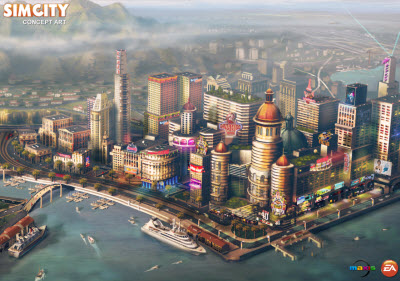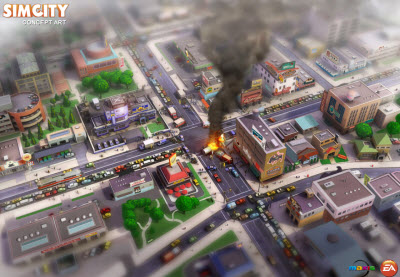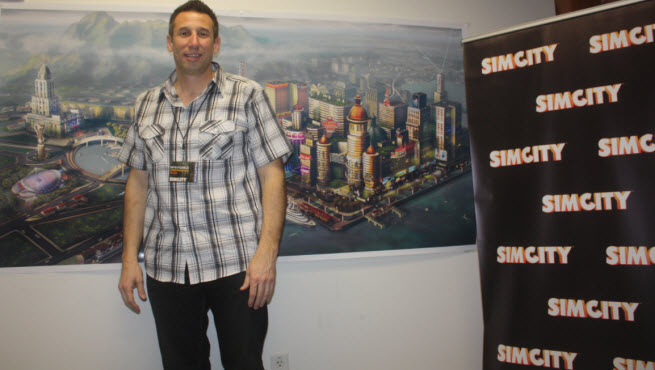Kip Katsarelis is lead producer for the new SimCity game Electronic Arts’ Maxis studio is developing. We recently made the trek to Emeryville, Calif., to get a look at the PC game, which is due out in 2013. The new SimCity is aimed at reviving a franchise that began in 1989. EA hasn’t released a major title in the franchise since SimCity Societies in 2007. And even then, its last full version of the game was SimCity 4, released in 2003.
Katsarelis’ job is to bring the franchise forward by a decade and take full advantage of the improved processing power of today’s PCs. To do that, his team has created a new game engine, dubbed GlassBox, the simulates everything down to individual Sims and buildings. The art style will be full 3D, and the cities will be interconnected. If one city produces smog, another city will feel the pollution. Here’s an edited transcript of our interview with Katsarelis:
 GamesBeat: Can you summarize your take on the new SimCity?
GamesBeat: Can you summarize your take on the new SimCity?
Katsarellis: One of the key pillars of SimCity has been the way it makes you think about the world. It is a game and you get sucked into it, but then you start looking at the real world a little differently. It kinda makes you think; it inspires people in different ways. (SimCity was one of the reasons I came to Maxis, actually got into the games industry.) We wanted to make sure that SimCity held true to that, so we made a little video about some of the things you’re going to be able to do in your city to impact the world.
GamesBeat: How many of these Sim games have you worked on now?
Katsarelis: I was on SimCity 4, and I worked on Rush Hour. And I’ve been at Maxis about 11 years. I worked on Spore and some other titles.
GamesBeat: The interesting challenge for you is this: You can use a lot more computing power and get a lot more detail and data and all that, simulating anything you want, but you also want to make the experience of playing the game simpler for players?
Katsarelis: Our new GlassBox engine is very powerful. It’s an agent-based simulation, so we’re tracking every single Sim in the world. We know if they’re sick or they have a job or if they’re unhappy. That’s pretty powerful. We could simulate down to the level of knowing when they have a hangnail. [He’s joking]. We don’t want to go that deep. It’s finding the right granularity for the simulation, so that people care about the details you give them. It’s simming at a city level, and your cities are now part of these greater regions that are interconnected. It’s really city planning at that regional level, and that’s important. There’s definitely simulation between cities now, which is totally new. It’s balancing the micro and the macro.
GamesBeat: And the art style, how did you look at that, how did you want to change it?
Katsarelis: SimCity is going 3D, which is a first in the franchise for us. One of the things we were inspired by was the tilt-shift look, and oversaturation, depth of field. We’re all big fans of model railroads, so we kinda came to this from that view. We want to build this tiny little model world that you’re going to be the god of. We just fell in love with that idea.
GamesBeat: The individual buildings almost look more detailed and bigger when you’re zooming in.
Katsarelis: Yeah. There’s a ton of detail. We didn’t go hyper-real, but there is a ton of detail in there, and we surface what’s important. I don’t know if you picked up on any of it. You can see inside buildings. There’s interior mapping going on, so it makes the insides come to life. There’s detail on the textures themselves, on the cars, everywhere. It all has meaning, too. We’re able to change values if things go to a depressed state in the neighborhood. We can get graffiti on buildings, things like that. We can really show off what’s going on in the simulation, or even in that particular building. I don’t know if you saw when the lights go on, we’ve got deferred lighting in the game, so we can tag every building with different lights.
 GamesBeat: [In a demo showing a fire scene, a fire truck with sirens blaring stopped at a street signal, even though there were no cars blocking it]. Looks like you have to watch out for little things, like the fire engine stopped at the signal?
GamesBeat: [In a demo showing a fire scene, a fire truck with sirens blaring stopped at a street signal, even though there were no cars blocking it]. Looks like you have to watch out for little things, like the fire engine stopped at the signal?
Katsarelis: Yeah, yeah. We’re still early in our traffic development. The plan is that fire engines will override traffic laws, so we’re still working on that one.
GamesBeat: It looks like you can almost start telling individual stories of your Sims in a city that operates from the ground up. Is that true?
Katsarelis: We’ve got the Sims, and so we want to bring out some characters within the simulation as well. Crime is a big part of SimCity, and we’re going to have different characters around that. Arsonists, bank robbers, things like that. We’ve got garbagemen. Every system has its characters and people associated with those systems.
GamesBeat: You have missions. It seems like everyone who makes an open world figures out soon enough that they have to give missions in order to direct people to undertake particular tasks?
Katsarelis: Yeah. I think that’s just the evolution of games in the last 10 years. Previous SimCities were very open. It was an open sandbox, open world. Here’s your palette of tools. Go to town. Build what you want. Gamers today, they want to be led through a story. They want to know what the rewards are. They want to achieve something in a small amount of time, or long amounts of time. But they want to know where they’re going. They want some help with that story. The Sims changed from the original Sims to Sims 2 when they introduced wants and fears. That added a little bit of that structure. It’s finding that right balance. We don’t want to make a linear, role-playing game. We still want to have that sandbox and play within that. Players are going to be able to opt into those missions.
GamesBeat: I guess the context is different, too, because there’s things like CityVille out there. We have simpler city simulations. You want to do something that’s over in the deep end, the deepest experience in city simulation?
Katsarelis: Definitely. But we want to serve it up in a way that even somebody who’s been playing a Facebook game could come over and not be blown away by the complexity. That’s why all the data layers are really simple and easy to understand. We want anyone to be able to pick it up and play it. And if you really want to get deep, that information is there, that simulation is there.
GamesBeat: How do you think people are going to find that the game reacts to them? Like, the game will change for a specific person. When do you think people are going to notice that this is what’s happening?
Katsarelis: I think they’ll notice it at the wider level. You look at your city from the highest perspective. You will see that a coal city looks very different from a normal, maybe a green city. It’s night and day. But I think it’s the characters that come up, the individual buildings themselves will all change. There’s that kind of large-scale city change that you’ll see at a glance, but when you get in close, your educated or high-wealth areas of town, maybe they’ll have solar panels on their roofs, or they drive Priuses. You’re going to notice a different character and feel, down to that Sim level, the individual Sim level.
GamesBeat: And then the environmentally conscious part of this game is new. It seems like that adds an interesting challenge to whatever you’re building. It also constrains you. You maybe can’t do your dream city with no regard to polluting your neighbors.
Katsarelis: You can build your dream city. That’s just it. We don’t want to stop you. Going green and green technology has always been part of SimCity, and we have that. One of the things we want to do is encourage is both sides of the spectrum. And there are more spectrums than just green and dirty. If you build a dirty, coal city, that’s a win state. That’s success. The Sims that live in your city are a little different than the Sims that live in your high-educated or high-tech city; they’ve got different demands and wants. They’re happier. They’re okay if it’s a little dirty. They need just the basics, like jobs. Really, the gameplay is different, but there are win states, and you are rewarded for each of those.
GamesBeat: It seems like it takes a huge effort to pull this together.
Katsarelis: Building games takes a lot of folks. And to build a city-builder, you’re not just building a room, a level. We’re building everything. I’ve seen much bigger teams. We’ve tried to keep it as tight as possible.
[Photo credit: Dean Takahashi]
![]() GamesBeat 2012 is VentureBeat’s fourth annual conference on disruption in the video game market. This year we’re calling on speakers from the hottest mobile, social, PC, and console companies to debate new ways to stay on pace with changing consumer tastes and platforms. Join 500+ execs, investors, analysts, entrepreneurs, and press as we explore the gaming industry’s latest trends and newest monetization opportunities. The event takes place July 10-11 in San Francisco, and you can get your early-bird tickets here.
GamesBeat 2012 is VentureBeat’s fourth annual conference on disruption in the video game market. This year we’re calling on speakers from the hottest mobile, social, PC, and console companies to debate new ways to stay on pace with changing consumer tastes and platforms. Join 500+ execs, investors, analysts, entrepreneurs, and press as we explore the gaming industry’s latest trends and newest monetization opportunities. The event takes place July 10-11 in San Francisco, and you can get your early-bird tickets here.
VentureBeat's mission is to be a digital town square for technical decision-makers to gain knowledge about transformative enterprise technology and transact. Learn More

